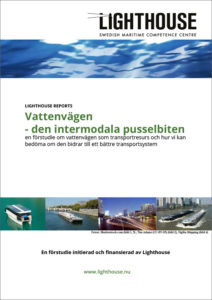The waterway – an intermodal piece. A feasibility study and joint project with the Swedish Transport Analysis, KTH, the Swedish Maritime Administration, Avatar, Vattenbussen and the Gothenburg School of Economics.
The aim of this pre-study was to identify and analyze how the waterway can be scaled and adapted to urban and regional transport systems in order to achieve an over-all more sustainable urban mobility.
The pre-study result was presented at the Lighthouse event on the 9th of February.
In the EU as well as in Sweden there is an outspoken interest for what potential opportunities the waterways might offer for improving the transport system. An often expressed solution is simply to shift cargo from the roads to the rail and seaborne modes of transport. The present study addresses feasibility and assessment of such solutions.
Initially it is illustrated how the Swedish inland waterways could be used for regional freight transport. Values are identified that potentially can be realised into a benefit. For instance; increased accessibility, improved land use in urban areas, reduced load on road and rail networks, increased transport redundancy and decreased vulnerability, increased system flexibility, energy efficiency and low noise. It also comes clear that nitrogen oxides and particle emissions from ships must decrease.
Technological issues related to winter navigation and environment risk assessment need attention as do the development of the interface to road and rail modes of transport e.g. means of reloading and the accessibility to quays and docks.
The study shows on a well-developed framework for modelling logistics and performing cost-benefit-analysis (CBA) although also showing great uncertainties and modelling weaknesses of aspects related to inland and urban waterways. I also becomes clear that assessment analysis focuses on effects from infrastructure investments and lack tools and methodology to assess the influence from measures to lessen transport work, e.g. by short cuts, or to optimise the existing system, e.g. by regulatory incentives to modal shift.
Finally, development opportunities are brought forward. It concerns improvements in technology, operation and infrastructure, but also in logistic models and CBA tools, providing urban planners and the transport buyer with high quality decision support.

